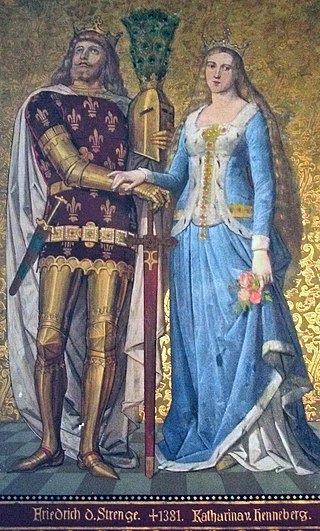Related Research Articles
Herman II was a member of the Conradine dynasty. He was Duke of Swabia from 997 to his death. In 1002, Herman unsuccessfully attempted to become king of Germany.

The Diocese of Bolzano-Brixen is a Latin diocese of the Catholic Church in northern Italy, with its seat in the city of Bolzano. Its territory corresponds with that of the province of South Tyrol with its predominantly German-speaking population. It is a suffragan of the Archdiocese of Trento.

Wiprechtof Groitzsch was the Margrave of Meissen and the Saxon Ostmark from 1123 until his death. He was born to a noble family of the Altmark, the son of Wiprecht of Balsamgau and Sigena of Leinungen. After his father's death in 1060, he was raised at the court of Lothair Udo II, Margrave of the Nordmark, in Stade.

Catherine of Henneberg was a Countess of Henneberg by birth and from 1347 by marriage Margravine of Meissen, Landgravine of Thuringia, etc. She was the wife of Margrave Frederick the Severe of Meissen. Via her, the House of Wettin inherited her father's Franconian possessions.
Henry VI of Plauen was Burgrave of Meissen, Lord of Plauen and Lord of Schleiz and Lobenstein.

Severinus of Saxony was a Saxon prince of the Albertine line of the House of Wettin.
Christoph von Stadion (1478–1543) was Prince-Bishop of Augsburg from 1517 to 1543.
Albert II was a member of the House of Ascania who ruled as the margrave of Brandenburg from 1205 until his death in 1220.
Albert II of Brunswick-Lüneburg, a member of the House of Welf, was Prince-Bishop of Halberstadt from 1325 until his death. His regnal numbers indicate that he was the second Bishop Albert of Halberstadt. His reign can be characterized as an almost unbroken series of conflicts with the Pope, his cathedral chapter, the city of Halberstadt and various neighbouring Lords and Princes.

Petrus Albinus was a professor at Wittenberg in Germany and is known as the father of Saxon historiography.

Anselm of Meissen was a priest of the Teutonic Order and the first actual Bishop of Warmia.
Saint Burchard of Meissen was the first Bishop of Meissen, from 968.
Eido I, also Ido, Eid or Ägidius, was the bishop of Meissen from 992 to 1015.
Albrecht I of Meissen was Bishop of Meissen from 1150 to 1152.
Gerung was bishop of Meissen from 1152 to 1170, and previously abbot of Posa or Bosau Abbey.
Martin was Bishop of Meissen from 1170 to 1190.
Dietrich von Kittlitz otherwise Dietrich II of Meissen or Dietrich II von Kittlitz was Bishop of Meissen from 1191 to 1208.
Bruno von Porstendorf otherwise Bruno II of Meissen or Bruno II von Porstendorf was Bishop of Meissen from 1209 to 1228.
Albrecht von Mutzschen otherwise Albrecht II of Meissen or Albrecht II von Mutzschen was Bishop of Meissen from 1258 to 1266.
Withego von Furra or de Wuor, otherwise Withego I of Meissen or Withego I von Furra was Bishop of Meissen from 1266 to his death.
References
- 1 2 Christian Hillen: Heinrich in: Institut für Sächsische Geschichte und Volkskunde (ed.): Sächsische Biografie (in German)
- ↑ Heinrich, Bischof von Meißen, Heinrich Theodor Flathe, ADB (in German)